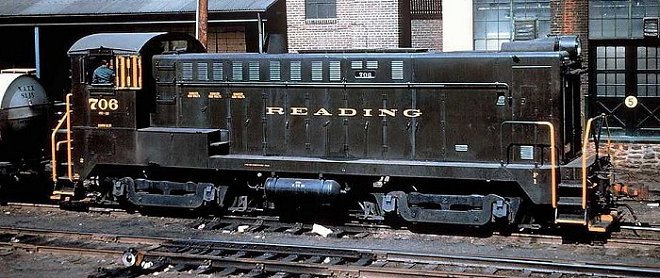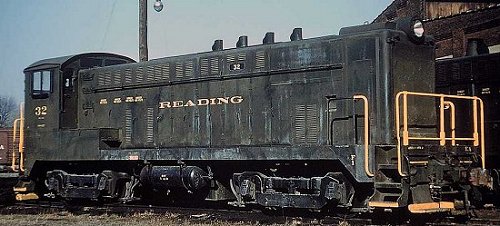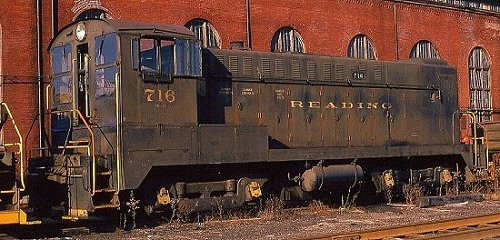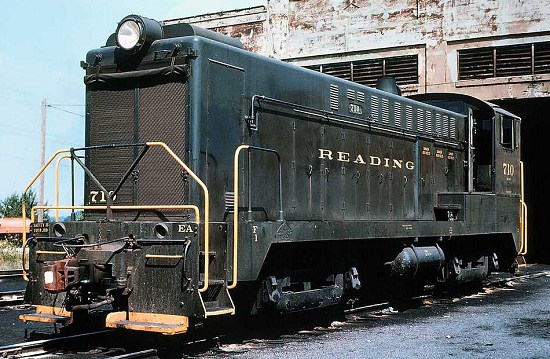Baldwin: DS4-4-1000

 The Reading was a major customer of the Baldwin Locomotive Works, not only in the steam era, but also after the advent of diesel power. With the lifting of War Production Board restrictions at the end of World War II, the Reading purchased several types of switchers from Baldwin, including the DS4-4-1000. There were TWO groups of this type of locomotive in service - the first group was classed OE-10 and numbered #26-39, arriving on the property in 1946-47. These units were non-turbocharged, as evidenced by the four exhaust stacks in the photo of #32 at right.
The Reading was a major customer of the Baldwin Locomotive Works, not only in the steam era, but also after the advent of diesel power. With the lifting of War Production Board restrictions at the end of World War II, the Reading purchased several types of switchers from Baldwin, including the DS4-4-1000. There were TWO groups of this type of locomotive in service - the first group was classed OE-10 and numbered #26-39, arriving on the property in 1946-47. These units were non-turbocharged, as evidenced by the four exhaust stacks in the photo of #32 at right.

The second group of DS4-4-1000 locomotives arrived in 1948-49. Classified OE-12, this group consisted of 30 units numbered #700-729. The principal difference between the two classes was in the prime mover - OE-12 locomotives had a 6-cylinder turbocharged engine, with a single exhaust stack as seen at right and below. In other cosmetic respects the locomotives were identical. All locomotives of this type were painted in the Reading's first-generation Pullman green paint scheme.
The Baldwins were the "quintessential Reading switcher" during the days of first-generation diesel power; they could be seen all over the Philadelphia and Reading Divisions, handling local switching duties in the various towns along main and branch lines. The railroad even used them in hump service at Rutherford and experimented with using them paired in road service! The Baldwins also had the distinction of the highest availability percentage among the three switcher manufacturers (Alco, EMD and BLW).
 The majority of the first group (OE-10) of DS4-4-1000s were traded to EMD in 1966 as credit toward new SW1500 units, with 3 locomotives being sold to Bethlehem Steel for use on the Patapsco & Back Rivers. The majority of the OE-12 units were retired in 1969; however, #702 and #712 were also sent to the P&BR, while #716 remained in Reading until 1975 as the locomotive shop switcher.
The majority of the first group (OE-10) of DS4-4-1000s were traded to EMD in 1966 as credit toward new SW1500 units, with 3 locomotives being sold to Bethlehem Steel for use on the Patapsco & Back Rivers. The majority of the OE-12 units were retired in 1969; however, #702 and #712 were also sent to the P&BR, while #716 remained in Reading until 1975 as the locomotive shop switcher.
MODELING NOTES: As noted in the text, the principal difference between the OE-10 and the OE-12 locomotives is in the prime mover - this plays out cosmetically in the exhaust stacks - the OE-10s had four, while the OE-12s had a single stack. All of the DS4-4-1000s were delivered in the Pullman green scheme, and remained in that paint until their retirement - none were repainted into the yellow/green or Reading green schemes, since most of them were out of service by the time the use of the new paint schemes became commonplace. Take note of such details as the handrails, and also the small piece of sheet metal on the front of the locomotive, on which the road number is applied - if not molded onto the body shell, this can be modeled with a small piece of styrene. Operationally, these locomotives were used primarily on the Philadelphia and Reading divisions - any location along those lines would be appropriate, just take note of the retirement dates when mixing motive power. The Baldwins had a solid reputation for reliability while in service on the Reading - one or two of these switchers would likely serve your layout well.
Did You Know?
Downloads
 A variety of Reading Company operations related documents, etc. that may be of use in your modeling efforts.
A variety of Reading Company operations related documents, etc. that may be of use in your modeling efforts.
 A variety of Reading Company operations paperwork, such as train orders, clearance forms, etc. that will help you operate your Reading layout in a prototypical manner.
A variety of Reading Company operations paperwork, such as train orders, clearance forms, etc. that will help you operate your Reading layout in a prototypical manner.
 Public Timetables, Employe Timetables, and Rulebooks that provide much useful operational information.
Public Timetables, Employe Timetables, and Rulebooks that provide much useful operational information.
 Signs, billboards, and other FREE goodies for your use. We ask only that you help spread the word about The Reading Modeler!
Signs, billboards, and other FREE goodies for your use. We ask only that you help spread the word about The Reading Modeler!

